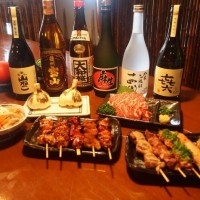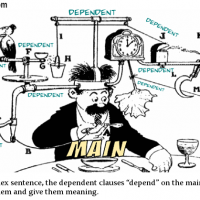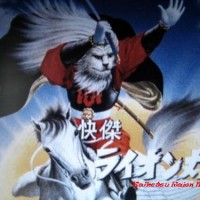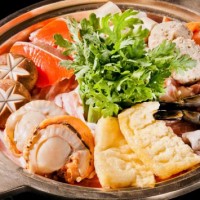Monthly Archives: January 2016
Thursday: Japanese Food
01/30/2016 blog
Yakitori/Japanese Skewered Chiken (https://en.wikipedia.org/wiki/Yakitori) (Sake goes well with Yakitori) (Still Beer Wins!) Yakitori is a simple skewered chiken. It is grilled with special sauce made with soy sauce or just with salt/pepper. Although this is a grilled and skewered chicken, its preparation takes long. As a result, men tend to stop by at the Yakitori Bar or buy some from a specialty Yakitori shops in Japan. (A Variety of Yakitori) Even in this technology age, Yakitori, which has conspicuous flavor, is extremely popular. You know why, don’t you? Yakitori makes me miss Japan a lot! Why don’t you come with ME when I go back to Japan next time? …
Wednesday: Japanese Manga
01/30/2016 blog
Ganbare!! Robocon (https://en.wikipedia.org/wiki/Ganbare!!_Robocon) <Characters Created by Ishi(no)mori Shotaro, Father of “Kamen Rider”> (TV Version) (With His Idol – Robin) Robocon is a Grade-G robot (Grade-A, B, C, ………G!?). He cannot live without making mistakes – really serious mistakes. Every single day he is messed up! Still, he is loved by everybody because he has got a good heart. This is a big discrepancy in people’s mind – “Robots are cold (because they are machine!) while humans are warm (because blood is circulating in their bodies!).” There are, however, not all humans are warmhearted in reality, as you may know it very well. And here – there were warmhearted robots! That …
Tuesday: Japanese Proverb
01/27/2016 blog
Kodomo-wa Shojikida (= Children and fools speak truth [cannot lie].) (You know this fable, don’t you?) In this modern days, not all children are innocent, unfortunately. Still, there are lots of innocent kids left in this wide world. So precious! My kids are not always honest with me, either. However, I can consult them when I find it difficult to judge something or someone from time to time. They can speak truth by nature, which we adult cannot help admiring. There used to be a genius comedian named Fujiyama Kanbi (1929 – 1990). There was no actor who could play the role of a fool as well as Fujiyama. When he played …
Monday: One Point Japanese Clinic
01/26/2016 blog
How To Use Conjunctions (6) (https://en.wikipedia.org/wiki/Conjunction_(grammar)#Subordinating_conjunctions) (Get a picture?) (Red parts are main clauses!) (This is possible, too!) Today’s topic is ‘Node.’ As usual, I would use Japanese Grammar (Keiko Uesawa Chevray & Tomiko Kuwahira, The McGraw-Hill Company Inc., 2011) as a reference. Node The “node” clause refers to a “cause” or a “reason” for the statement of the main clause. Since “node” is used in an objective statement, the subjective expression, such as “- mashoo (=let’s -),” “- te kudasai (= please do -),” and so on, does not take place in the main clause, while “kara” allows those subjective expressions in the main clause. (Japanese Grammar) …
Friday: Japanese Hero
01/25/2016 blog
Miyamoto Musashi (https://en.wikipedia.org/wiki/Miyamoto_Musashi) (Who would have imagined that Musashi would be this famous when young?) Musashi (武蔵) can be read ‘Takezo.’ ‘Takezo’ sounds like he is a little brat, which was really true – actually he was worse than that. In his neighborhood, Takezo was regarded as a cancer to the community. Rough and violent. No intelligence of any kind. Nobody liked him. What, in the world, transformed Takezo into Musashi, who became a worldly famous swordsman for the next centuries. It was Buddhist education that was given by his uncle and aunt, who raised him since he was 7 years old. Yoshikawa Eiji (https://en.wikipedia.org/wiki/Eiji_Yoshikawa), the notable Japanese author, wrote a …
Thursday: Japanese Food
01/25/2016 blog
Motsunabe (https://en.wikipedia.org/wiki/Motsunabe) (Motsunabe: Another Kind of Nabemono: https://en.wikipedia.org/wiki/Nabemono) The roots of Motsunabe dates back to post World War II perios, when Korean coal miners (temporary immigrant workers) started to cook this kind of nabemono in Hakata, Fukuoka, in Japan. You cannot exactly say this is Hakata’s local cuisine because it was not until 1992 that Motsunabe became very popular in Tokyo, Japan, after the Economic Bubbles burst. Ingredients are beef or pork tripe or other offal. That’s why this nabemono cost a lot less! Economy and efficiency! To eliminate the tripe or offal smell, green onions (scallions) or garlic chives are used most frequently. Because of the significant Korean influence, …
Wednesday: Japanese Manga
01/21/2016 blog
Kaiketsu Raion Maru (Lion-Maru) (https://en.wikipedia.org/wiki/Kaiketsu_Lion-Maru) (The original Manga Version) (TV Version (54 episodes): https://youtu.be/lo6DyikmlzQ) “Raion Maru” was cool when TV series started. This is categorized as Jidaigeki (https://en.wikipedia.org/wiki/Jidaigeki) and the hero of this TV drama is a Ninja (https://en.wikipedia.org/wiki/Ninja). The time is Sengoku Jidai (https://en.wikipedia.org/wiki/Sengoku_period). Like “Kamen Rider,” which was featured in my blog previously, Shishi (= Lion) Maru, the Hero Ninja, transforms into “Raion Maru.” Japanese kids in 70’s were simply hooked! (Shishi Maru shouts, “Kazeyo (= Wind)! Hikariyo (=Light)! Henshin (= Transform)!”) Transformation! That’s the key to SUCCESS in learning LANGUAGES! I will help YOU to transform into A JAPANESE PERSON! Special Trial Lesson $19.99 <–Click here!
Tuesday: Japanese Proverb
01/20/2016 blog
Neko-no Rusu-ni Nezumi-ga Abareru (= When the cat’s away, the mice will play.) (Scary Cat! If he is gone…) (this happens!) Usually “a cat” in this proverb stands for “some authority” while “mice” for “subordinates.” That is, subordinates will take advantage of circumstances in the absence of a controlling entity. (Example) When the teacher left for a few minutes, the children nearly wrecked the classroom. When the cat’s away, the mice will play. Jill: You shouldn’t bereading a novel at your desk. Jane: But the boss isn’t here. And when the cat’s away, the mice will play. [McGraw-Hill Dictionary of American Idioms and Phrasal Verbs. 2002. ] In today’s business …
Monday: One Point Japanese Clinic
01/19/2016 blog
How To Use Conjunctions (5) (https://en.wikipedia.org/wiki/Conjunction_(grammar)#Subordinating_conjunctions) (Today’s Topic – ‘Kara/Because’) According to “Japanese Grammar” (Keiko Uesawa Chevray & Tomiko Kuwahira, McGraw-Hill, 2011), “Kara” is explained this way: The “kara” clause indicates the “reason” for the main clause, and it corresponds to “because” in English. Since the “kara” clause is a subordinate one, the predicate in the clause is usually described in the plain form, and the subject in the clause is marked by “ga” when it is different from the one in the main clause. I. Copula + kara Kino-wa hima datta kara, eiga-wo mini ikimashita. (= I went to see a movie because I was free yesterday.) II. I-adjective + …
Friday: Japanese Hero
01/18/2016 blog
Ichiro (Suzuki) (https://en.wikipedia.org/wiki/Ichiro_Suzuki) (You know him, don’t you?) The Japanese are getting deteriorated year by year, so as the Japanese culture. More and more great Japanese people have passed away without leaving their successors. I have been around in this planet, mainly in Japan and US, for quite a while. As I are getting aged, I find myself alone because I don’t have people I can turn to for a guidance in life. I haven’t achieved anything significant. Days have passed by without me doing anything admirable. A philosopher and poet in Muromachi period (https://en.wikipedia.org/wiki/Muromachi_period) called Hosokawa Yoriyuki read a poem, in which he stated, “I am ashamed of myself at the …
Thursday: Japanese Food
01/17/2016 blog
Chanko Nabe (https://en.wikipedia.org/wiki/Chankonabe) (Chanko Nabe: Watch this interesting video! https://youtu.be/7KcFGjAUgcU) Chanko Nabe used to be exclusively for Sumo (https://en.wikipedia.org/wiki/Sumo) Wrestlers in Japan so they can gain weight as soon as they can. They say Sumo Wrestlers eat only twice – huge meals! They get up and start their harsh training without eating breakfast. After training, they are exhausted and starved to death. At this time, they devour Chanko Nabe! After they became totally full (120%!?), they take a nap. They repeat this every single day so they can put on weight drastically. Chanko Nabe is very nutritious, which helped it to be popular among the general public. (Younger Sumo Apprentices Cooks …
Wednesday: Japanese Manga
01/16/2016 blog
Kometto-san/Princess Comet (https://en.wikipedia.org/wiki/Princess_Comet) (Manga Version) (TV Version) (Opening Song: https://youtu.be/hcKa3EUrd8w) “Kometto-san” started as a TV drama, whose original concept came from an American Classic “Mary Poppins <https://en.wikipedia.org/wiki/Mary_Poppins_(film)>,” in 1967 (79 episodes in total). Then, Yokoyama Mitsuteru (https://en.wikipedia.org/wiki/Mitsuteru_Yokoyama) created and illustrated this cute drama in Bi-Weekly Margaret (girls’ magazine) <https://en.wikipedia.org/wiki/Margaret_(magazine)>. Kometto-san uses the baton when she uses her magic. (Episode 1 – 19 were monochrome: https://en.wikipedia.org/wiki/Monochrome_painting) (Betan) Like Kommeto’s mascot puppet called “Betan (a picture above),” lots of puppetoon (https://en.wikipedia.org/wiki/Puppetoon) were used in this drama. A heroine, Kometto-san, sings throughout the drama and so do the parents, who hired Kometto-san as their nanny for their two boys! Technically speaking, “Kometto-san’ was a musical …
Tuesday: Japanese Proverb
01/14/2016 blog
Neko-wa Kyusho (Ari) (= A cat has nine lives.) (Cat: https://en.wikipedia.org/wiki/Cat) Everything in this world is in balance. In Chinese philosophy, this is called “Yin Yang (https://en.wikipedia.org/wiki/Yin_and_yang).” In animal world, we have heard it said that cats are Yin (animals) while dogs are Yang. This concept or myth has undoubtedly been believed for centuries. One of the good examples is the novel named “Kuro Neko (Black Cat)” written by Edogawa Ranpo (Edgar Allan Poe: https://en.wikipedia.org/wiki/Edgar_Allan_Poe). He wrote a lot of fictions, but this piece is awesome. He established the genre of ‘ghost stories.’ (Poe) In Western world, there is a saying, “A black cat crossing your path will bring you a bad luck.” …
Monday: One Point Japanese Clinic
01/12/2016 blog
How To Use Conjunctions (4) (https://en.wikipedia.org/wiki/Conjunction_(grammar)#Subordinating_conjunctions) (Subordinating Conjunctions Chart) (Yes, it does!) (What Fun!) Today we focus on “Aida/Aida (ni),” which tells you which occurs first or what you did while you are doing XXX, for example. Let’s take a look at those example sentences! I. Noun + no aida/aida ni Gakusei-no aida ni takusan ryokoo-wo suru tsumorida. (= I will travel a lot while I am a student.) II. I-adjective + aida/aida ni Sakana-ga atarashii aida ni shushi-wo tsukurimashoo. (= Let’s make sushi while the fish is fresh.) III. Na-adjective + aida/aida ni Shigato-ga taihenna aida wa, terebi-wa miraremasen. (= I cannot watch TV while I …
Friday: Japanese Hero
01/10/2016 blog
Saito Hitori (Hitori’s Store Logo) Saito Hitori (1948 – ) is a super-successful Japanese entrepreneur, author, speaker, and healer. Without any decent educational background, Saito knows things, sees things, and thrives in everything he does. Lots of people (probably several thousands all over the world) admire him and worship him as a God or a Guru. That is not only because Saito is super-successful in his business, but also because he is spiritually oriented. He claims that a fireball, which only he could see and which he regards as a God, showed up and taught him everything he needed to know about life when he was a kindergartner. Since then, according …


















